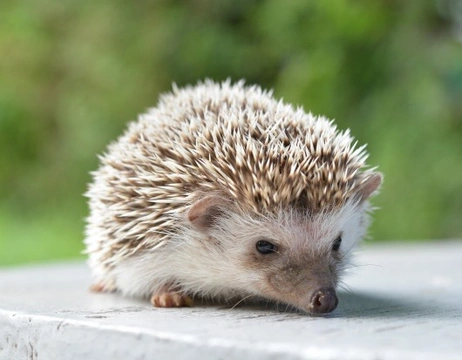
Caring for a pet hedgehog
There is only one species of hedgehog that is designed to be kept happily in captivity, and that is the African pygmy hedgehog, a hybrid breed of two other African hedgehog species. These are now becoming very popular as pets across the world and within the UK, and are undeniably adorable and highly entertaining little animals! It is vitally important to remember that only this captive-bred species is suitable to keep as a pet, and you should not seek to find and domesticate wild hedgehogs within the UK; they will not thrive in captivity, and their numbers are already on the decline.
If you think the African pygmy hedgehog sounds like a good choice of potential pet for you, read on to learn more about these little animals and the care that they require.
Can you handle a pygmy hedgehog?
Like any animal, how tame your hedgehog will become depends on how often and how well they are handled, and ideally, handling should start while your hedgehog is young. As very small animals, the pygmy hedgehog may become frightened or alarmed by overenthusiastic handling, so approach them calmly and quietly and move slowly. If your hedgehog curls up into a spiky ball, they are likely alarmed and feeling defensive, so back off until they relax. In order to pick up your hedgehog, scoop them up into your hands, supporting their underside. Once your pygmy hedgehog has got used to the approach of people and being handled regularly, they will usually learn to sit quite happily in your hands or lap for a while.
Hedgehogs have very poor eyesight, and so they are not apt to use visual cues to pick one member of the family out from another; instead, they use their sense of smell to work out who is handling them. You might find that they are much more outgoing and welcoming of the person that handles them the most!
Exercise for a pet hedgehog
In the wild, hedgehogs are always on the go during their waking hours, and cover some fairly wide distances when out and about foraging for food. As fairly rounded little animals anyway, domestically kept pygmy hedgehogs can be prone to obesity due to a lack of exercise, so it is important to provide for their natural need to be active. There are a great many different types of toys and pieces of equipment that you can use within the tank to allow your hedgehog to stretch their legs and stay interested, including specially designed hedgehog exercise wheels!
They will also enjoy running through tubes and pipes, and being allowed to walk around loose in the home when carefully supervised.
Health and veterinary care for a pygmy hedgehog
One important point to bear in mind when considering buying a pygmy hedgehog is that not all veterinary practices will be experienced or equipped to treat hedgehogs, and you may need to find a specialist exotics vet to provide your veterinary care. This may mean rather expensive visits, and potentially having to travel a fairly long distance to get treatment.
The pygmy hedgehog is relatively low maintenance and tends to be healthy, although obesity, as mentioned above, can shorten their lifespan. The average longevity of the pygmy hedgehog in captivity is three to five years.
When caring for your hedgehog, it is important to remember that they can harbour fleas just like dogs and cats can, so if you have other animals, schedule flea treatments into your hedgehog’s care along with your other pets, using a product recommended by your vet. Also, the nails of the hedgehog grow all the time, and can become overly long within a short period of time in captivity. You will need to schedule nail trims with your vet as and when necessary, or ask your vet to teach you how to trim your hedgehog’s nails yourself.
What do pygmy hedgehogs eat?
In the wild, hedgehogs forage for food during the time when they are awake, eating a selection of slugs, snails and insects. Hedgehogs are nocturnal and so eat at night, and the best time to feed them is just before you go to bed. You can buy a specially prepared hedgehog food mix from some larger pet stores, but this is not available in all areas. You can feed your hedgehog cat food in the absence of special hedgehog food, with treats such as crickets, earth worms, slugs and mealworms when you can find them!
Your hedgehog should also have free access to clean, fresh water, such as from a wall-mounted water bottle.
Housing requirements
Pygmy hedgehogs are solitary animals that are best kept on their own, as two hedgehogs kept together may have a tendency to fight. The larger the tank you can provide the better, as hedgehogs need to keep active and have plenty of room to move around. The floor of the tank should be smooth, rather than wire, as wire can damage the delicate feet and claws of your pet.
The ideal choice of bedding is shredded paper, as any other wood-based product such as shavings may contain oils from the wood, such as cedar or pine, which can irritate the skin and your hedgehog’s respiratory system. You should keep the temperature of the tank between 72-85 degrees Fahrenheit, and ensure that the tank contains a hidey hole for your hedgehog to sleep in.
The tank should be cleaned out on a weekly basis, with the bedding and substrate replaced for fresh.



